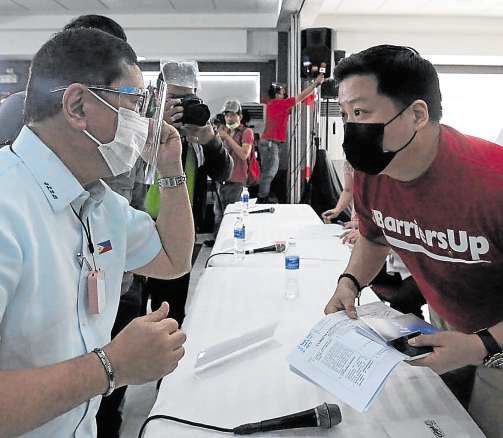Talks to ease NLEx traffic in deadlock

NO BARRIERS NLEx Corp. president Luigi Bautista (left) and Valenzuela City Mayor Rex Gatchalian hold a dialogue on the RFID system at Valenzuela City Hall. —MARIANNE BERMUDEZ
Motorists using the North Luzon Expressway (NLEx) will still pay no toll as a meeting between Valenzuela City officials and executives of the tollway operator ended on Monday with no agreement on how to prevent vehicular congestion on the turnpike caused by the mandatory shift to electronic toll collection.
Valenzuela Mayor Rex Gatchalian told reporters that the business permit of NLEx Corp. remained suspended after the two sides failed to agree on the complete removal of barriers at the toll gates.
During the meeting, held to resolve the conflict between the local government and the tollway operator over vehicular congestion on the expressway that worsened with the imposition of electronic toll collection starting Dec. 1, Gatchalian rejected NLEx Corp.’s proposal to raise the barriers only during peak hours when the company claimed that its radio frequency identification (RFID) system had a 98 percent readability rate.
No barriers
Gatchalian wanted no barriers—or open-road tolling—and said NLEx Corp. should not make motorists suffer for problems with its service.
Luigi Bautista, NLEx Corp. president, and general manager, argued that safety might become a problem if the barriers were raised at all times, as authorized vehicles would be able to go through the toll plazas.
“The continuous ‘barriers up’ [proposal] is where we are headed. That’s open-road tolling … But there will be safety issues because anyone will be able to pass through toll plazas, and we cannot assure the safety of motorists,” Bautista said.
He said there could also be law enforcement problems because his company had no authority to apprehend erring motorists. He added that his company needed access to the databases of the operators, the Land Transportation Office, and the Land Transportation Franchising and Regulatory Board to be able to do “efficient toll collection and contactless apprehension.”
But Gatchalian turned NLEx Corp.’s reason for raising the barriers only during peak hours on the company.
“So is safety not a problem during rush hours?” Gatchalian said. “You only like it when it’s convenient for you, but you don’t like it when it’s convenient for motorists.”
The mayor cited motorists’ reports that their Easytrip accounts were charged after the Valenzuela government declared a “toll holiday” last week, which he said proved that NLEx Corp. had the technology for open toll plazas.
Jose Arturo Garcia Jr., general manager of the Metropolitan Manila Development Authority who was also present at the meeting, suggested that the barriers be lowered only during curfew or in the wee hours of the morning since there were few motorists on the road.
Time to study proposal
Bautista asked for more time to study the open toll plaza system and said NLEx Corp. would discuss the matter with its parent company then get back to the local government.
Speaking to reporters after the meeting, Gatchalian said he would wait for NLEx Corp.’s response to his proposed solutions to the congestion on the expressway.
Asked what he would do if the operator rejected his no-barriers proposal, Gatchalian said he hoped the operator would find something else that would be acceptable and satisfactory.
“We’re here to find solutions. I don’t want to impose. My job here is to regulate their business permit. I am not the expert here,” Gatchalian said.
NLEx Corp. said the adoption of open-road tolling would take two to three years, as the country first has to build the infrastructure for that system.
Gatchalian suspended NLEx Corp.’s business permit on Dec. 7 after the company failed to solve problems with its RFID system that were causing kilometerslong tailbacks from the toll plazas.
The local government then declared a toll holiday, allowing the free flow of vehicular traffic—without charge.
Some motorists reported, however, that their accounts were charged even though they were already at home and the charge was done at the time they drove through the toll plaza, a phenomenon that Gatchalian called “ghost rider.”
Other motorists complained about slow RFID reloading, which took 45 minutes to 24 hours before their new balances were reflected on their accounts.
Solved by January
NLEx Corp. promised to solve these problems by Jan. 30, 2021. It also agreed to bring back cash lanes at toll plazas for motorists who did not have enough credits on their accounts or were yet to get their RFID stickers.
Northwesterly Domingo, NLEx Corp. vice president for operations, said the company would also relocate stickering sites and reloading booths to gas stations and customer service centers before the entrance to the expressway to prevent congestion at the toll plazas.
But these services will be maintained at the toll plazas in Balintawak, Quezon City, and Bocaue in Bulacan where there are bigger barriers and more need for reloading stations, he said.
The company, he said, would also deploy teams to assist motorists encountering problems with the RFID system.
Glenn Campos, NLEx Corp. vice president for technology, said the company, to solve the reloading problem, had begun implementing an application program integration that would allow the programs of payment channels and the operator’s account management system to reflect reloading in real-time.
Campos said the program would be fully implemented by January 2021. INQ